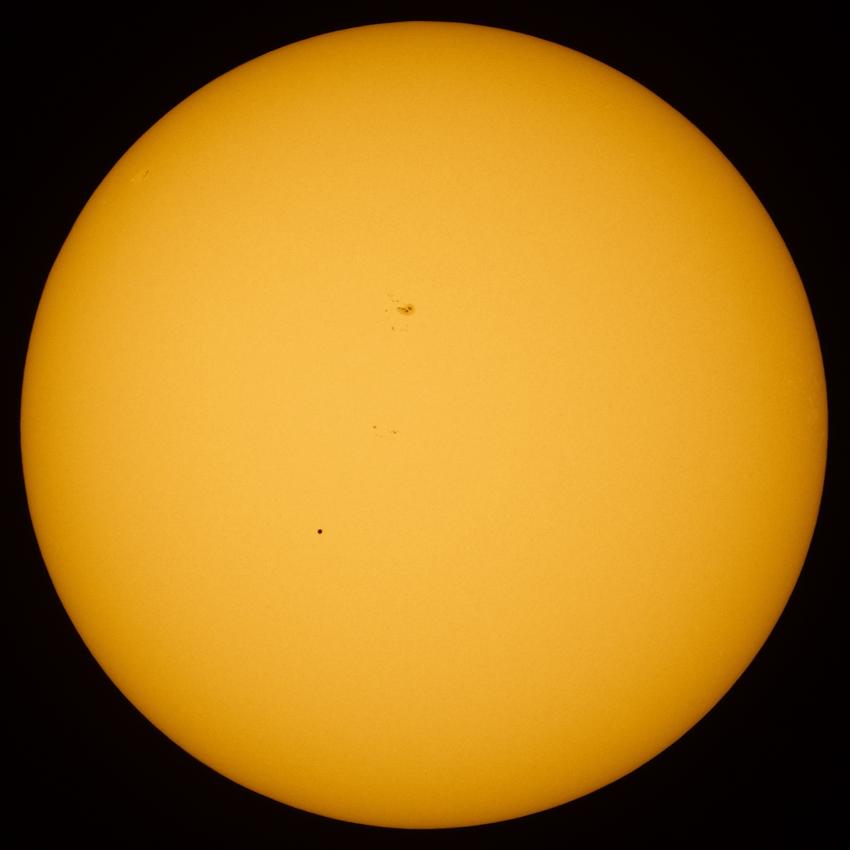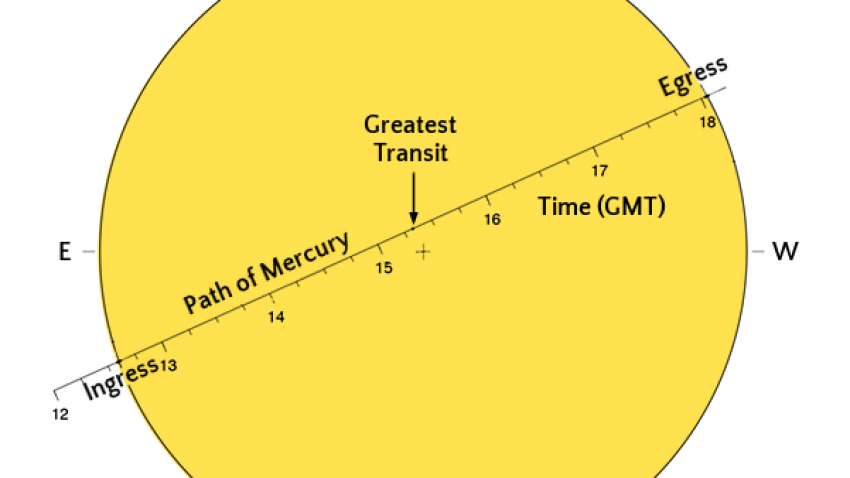November to Feature Rare Astronomical Event That Won T Occur Again Until 2032
A rare transit of Mercury will take identify on 11 November, when the smallest planet in our Solar System volition laissez passer directly betwixt the Earth and the Sun. The last time this happened was in 2016, and the next volition exist in 2032. During the transit, which takes place in the afternoon in the United kingdom, Mercury volition appear every bit a dark silhouetted disc set confronting the bright surface of the Sun.
The transit begins at 1235 GMT, when the border of Mercury appears to affect the edge of the Sun, and ends at 1804 GMT when the edge of the silhouetted planet appears to get out the Sun. Observers in different locations will see the transit taking identify up to ii minutes before or afterward these times, as the planet volition appear to take a slightly different path across the Lord's day.
On the morning of 11 November, UK amateur astronomical societies and public observatories will exist running events where members of the public can safely enjoy the transit, as well equally live webcasts of the spectacle. The Royal Astronomical Gild will be supporting a (free) event run by the Baker Street Irregular Astronomers in Regent's Park, central London, where members of the public tin volume places to come and view the transit using appropriate equipment at no cost.
Professor Mike Cruise, President of the Imperial Astronomical Society, is neat for people to experience the transit for themselves. "This is a rare issue, and we'll have to look 13 years until information technology happens once more. Transits are a visible demonstration of how the planets motion around the Sun, and everyone with access to the right equipment should take a look, or go to an organised upshot if the weather is clear, or alternatively follow i of the live webcasts. I do want to stress though that people must follow the condom advice – looking at the Dominicus without appropriate protection can seriously damage your eyes."
The entire outcome is visible from the eastern United States and Canada, the southward-western tip of Greenland, almost of the Caribbean area, cardinal America, the whole of South America and some of west Africa. In Europe (including the United kingdom of great britain and northern ireland), the middle East, and nigh of Africa, the sun volition set before the transit ends, and so the latter part of the consequence will not be visible. In most of the Us and Canada, and New Zealand, the transit will be in progress as the sun rises. Observers in eastern Asia, southern and south-eastern asia, and Australia will not exist able to see the transit.
Mercury completes each orbit effectually the Sun every 88 days, and passes betwixt the Earth and Sun every 116 days. As the orbit of Mercury around the Lord's day is tilted compared with the orbit of the Earth around the Sun, the planet normally appears to laissez passer to a higher place or below our nearest star. A transit tin merely take place when the Earth, Mercury and the Lord's day are exactly in line in iii dimensions.
There are 13 or xiv transits of Mercury each century, so they are comparatively rare events, though each one tin typically be seen over a large area of the Earth'due south surface. A transit was beginning seen in 1631, two decades after the invention of the telescope, by French astronomer Pierre Gassendi.
At any time, Mercury blocks out no more than than a tiny function of the light from the Sun. This means that the consequence should NOT be viewed with the naked heart. Looking at the Lord's day without appropriate protection, either during the transit, or at any other time, can crusade serious and permanent damage to the optics.
The Lodge for Pop Astronomy has an online guide on how to safely view the transit, for instance by projecting the solar image with binoculars or a telescope. Mercury is too pocket-sized to be visible using the pinhole projectors that worked successfully in the solar eclipse in March 2015, and similarly cannot exist seen by using 'eclipse glasses' with solar filters.
Observers with admission to a moderate-sized telescope with an advisable condom filter should be able to see Mercury as a dark disc, comparable in credible size to a sunspot, but somewhat darker. At the beginning and end of the transit, when Mercury's limb is shut to the border of the Dominicus, it may besides be possible to run across the 'black drop' effect, where a broad line appears to connect the planet to the solar limb. This is idea to result from the quality of the telescope in employ, and turbulence in the Earth'southward atmosphere (and so-called 'seeing'), and has in the past compromised efforts to record transit times.
As information technology is and then close to the Sun, Mercury is hard to study in detail using telescopes on Earth. Ii NASA space probes have visited Mercury, Mariner 10 in 1974 and 1975, and MESSENGER, which orbited the planet from 2011 until a deliberate crash landing in 2015. The European Space Agency mission BepiColombo launched in 2017, and is expected to study the planet from 2024 onwards. Britain scientists are making a significant contribution to this project.
Transit techniques are also deployed to study objects outside our Solar Arrangement, and for example missions like the NASA Kepler infinite telescope used it to confirm the presence of 2,662 planets in orbit around other stars. The same technique volition be used by the European Space Agency'due south PLATO mission, expected to launch in 2026.
Media contacts
Dr Morgan Hollis
Royal Astronomical Society
Mob: +44 (0)7802 877 700
press@ras.ac.uk
Dr Sheila Kanani
Royal Astronomical Society
Mob: +44 (0)7802 877 698
skanani@ras.ac.uk
Dr Robert Massey
Royal Astronomical Society
Tel: +44 (0)20 7292 3979
Mob: +44 (0)7802 877 699
rmassey@ras.air-conditioning.united kingdom of great britain and northern ireland
Ms Lucinda Offering
Imperial Astronomical Society
Mob: +44 (0)7889 226 543
loffer@ras.ac.united kingdom
Images and captions

A photograph of the transit of Mercury of ix May 2016. Mercury is seen in silhouette every bit the dark dot below left of centre. The other night features are sunspots.
Credit
Wikipedia / Elijah Mathews

A diagram showing the path of Mercury in front on the Sun on xi November 2019. All times are in GMT. Mercury will appear to move from left to correct as the event progresses, from ingress (the offset) at 12:35 until egress (the end) at eighteen:04.
Credit
Royal Astronomical Society
Events and webcasts
- Observatory Science Centre, Herstmonceux
- Royal Observatory Greenwich, guide and livestream
- Baker Street Irregular Astronomers, Transit of Mercury observing meeting
- NASA: 2019 Mercury Transit
- Club for Popular Astronomy: Transit of Mercury 2019
- Interactive map of public viewing events in Africa (courtesy of the Due south African Astronomical Observatory)
Notes for editors
The Royal Astronomical Society (RAS), founded in 1820, encourages and promotes the study of astronomy, solar-system scientific discipline, geophysics and closely related branches of scientific discipline. The RAS organises scientific meetings, publishes international inquiry and review journals, recognises outstanding achievements past the honor of medals and prizes, maintains an extensive library, supports education through grants and outreach activities and represents UK astronomy nationally and internationally. Its more than 4,400 members (Fellows), a third based overseas, include scientific researchers in universities, observatories and laboratories besides as historians of astronomy and others.
Follow the RAS on Twitter, Facebook, Instagram and YouTube
Source: https://ras.ac.uk/news-and-press/news/rare-transit-mercury-take-place-11-november
0 Response to "November to Feature Rare Astronomical Event That Won T Occur Again Until 2032"
Enviar um comentário